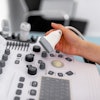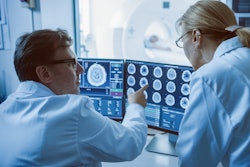His career is one people are told often they can't have.
About a year ago, Mitchell Schnall, MD, PhD, was appointed to the newly created role of senior vice president for data and technology solutions at the University of Pennsylvania Health System (UPHS). Schnall's promotion followed two terms as chair of radiology in Penn’s Perelman School of Medicine.
Schnall spearheads the health system’s efforts to understand new tools and approaches and determine how best to implement them across UPHS to improve the provider experience, boost health outcomes for patients, and drive efficiency across the health system.
At Penn since leaving high school, he has been on an upward trajectory. As most AuntMinnie readers already know, the organization is big, with great complexity and richness, according to Schnall in Episode 14 -- Part 2 in a series -- of AuntMinnie's Keeping Up with the Radiologists podcast.
"I've been fortunate to be in roles that allowed me to work collaboratively with many, many other universities and healthcare providers across the country," Schnall said.
He's seen the history of radiology, seen hospitals decline, and estimates that about one-sixth of all physicians in the U.S. go through Penn at some point.
In this episode, Schnall with co-host Saurabh (Harry) Jha, MD, takes listeners back to when radiologists spent a lot of their time doing procedures to get images -- myelograms, GI studies, and all sorts of fluoroscopy, that have largely been replaced by high-fidelity, 3D high-contrast imaging between modern CT and modern MR, Schnall said.
"It was a very different existence," he recalls. "You spent the morning making the images and the afternoon reading the images."
"Most people couldn't fathom that today," Schnall continued, "but because MR came on the back end of what just was a CT revolution -- we saw the impact of 3D imaging and saw the gap that MR filled immediately, which was the soft tissue-contrast opportunity that was more modest than CT -- I think there was unbridled enthusiasm. With AI systems today, there's a little bit of guarded enthusiasm."
AI systems in radiology
MR didn't change the paradigm, but AI is different today.
"Change is the way AI is viewed, compared to MR when it was being developed," Schnall said.
Is it a loss for the profession that radiologists are divorced from image acquisition?
Schnall and Jha share their opinions, experiences, and concerns about how the work of radiologists has changed dramatically and is moving away from them understanding medical imaging technology.
However, Schnall cautioned, "if we don't have the knowledge base and understand the technology and how it works and interacts with our patients, then we're going to lose that opportunity to play that technology role, which I think really weakens us as a specialty. We can't give up that expertise that allows us to continue to be the stewards of technology."
What lessons are there from looking back at historical trends of new technology adoption in radiology?
"In many ways, the patients are always going to win, and the technology that provides the best care in the most effective way is typically going to prevail," Schnall noted. "There may be noise in getting there ... temporary times where something that doesn't make sense seems to be winning.
"In the end, the system will migrate to wherever the best patient care is, and the trends will tail off. We've seen that over time."
Convenience is very important, as is safety profile and costs, according to Schnall.
"Everybody recognizes that there's a lot of fiscal pressure on healthcare organizations and on the healthcare system now," Schnall continues, during the segment on vendors, competition, market share.
Penn was among the first institutions to go filmless, and there were tradeoffs, Schnall also recalls. Some workstation designs were unworkable.
Yet, it was predicted long ago that imaging and utilization would increase, and clinical skills would diminish, according to Jha, and there has been much talk about specialists such as cardiologists and pulmonologists encroaching into imaging.
It could happen, according to Schnall, but there are two key reasons why it hasn't. Listen to the episode around the halfway point to learn why, and stay tuned beyond for operation margin talk, payer mix, and opportunities for academic centers.
Future of radiology
"Right now the paradigm is that radiology is a very special, high-cost nuanced resource that's reserved for ... high-end imaging," Schnall said. "And we've been seeing that sort of model of imaging erode as it's becoming faster, more convenient, and it has become cheaper -- you're seeing it move closer and closer to the front end."
"Clinical skills are evolving," he added. "Rather than getting referred to a specialist physician that then orders a high-end imaging study ... we become part of the upfront management of that process," Schnall suggests, teasing a "physician-plus-radiologist model" of specialist approach.
When the announcement was made that Schnall would cede the chair of radiology position at Penn Medicine, he set out to lead a new technology- and data-driven era. Also in this episode, Jha probes Schnall's vision for the road ahead.
It begins with the electronic health record (EHR) and Schnall working between two sides of the UPenn healthcare network: information technology and clinical practice.
"It used to be that radiology was a little unique in that our workflow in everything we did was governed by our IT systems," Schnall explains. "But with the growth of the electronic health record and how it manages every single workflow in medicine, everything in medicine is now governed and relies on our IT systems, and that's true in almost every industry now."
That medicine has been criticized over the years for not using IT resources effectively to automate is unfair, Schnall asserts.
"Medicine is a lot more complex than a lot of other industries, but the tools are getting better and better and more sophisticated," he said. "We can make everything we do more effective and more efficient if we can find a way to marry the tools to our daily work needs."
Listen to the full episode now.
More impressions:
{02:42:16} Career pathway
{04:42:21} When MRI became the buzz
{08:45:14} Loss for the profession
{10:04:03} Radiologists' role
{11:38:20} Coronary angiograms
{15:00:18} Technology that prevails
{16:55:07} Competition and market
{21:43:05} First PACS and tradeoffs
{29:07:17} Specialists encroaching
{34:07:01} Economics
{35:38:02} Payer mix
{37:46:13} Flipping the paradigm
Featured:
Mitchell Schnall, MD, PhD, is a physician at Penn Medicine in its abdominal imaging services program. Schnall served as chair of the department of radiology and the Eugene P. Pendergrass Professor of Radiology at the Perelman School of Medicine, before taking on the role of senior vice president for data and technology solutions for the University of Pennsylvania Health System in 2024. Schnall still serves as group co-chair of the ECOG-ACRIN Cancer Research Group since its founding in 2012. He is an international leader in translational biomedical and imaging research, working throughout his career across the interface between basic imaging science and clinical medicine to ensure effective integration of radiology research with other medical disciplines.
Saurabh (Harry) Jha, MD, is an associate professor of radiology at the Hospital of the University of Pennsylvania. Jha obtained a master’s degree in health policy research from the Leonard Davis Institute at the University of Pennsylvania. He earned his medical degree from the United Medical and Dental Schools of Guy’s, King’s, and St. Thomas’ Hospitals. Jha developed Value of Imaging, a set of radiology educational resources.
This episode of Keeping Up With the Radiologists is brought to you by AuntMinnie.com in collaboration with Penn Radiology. The series is also available on Spotify, YouTube Music, and Apple Podcasts. Check back for new episodes!




















